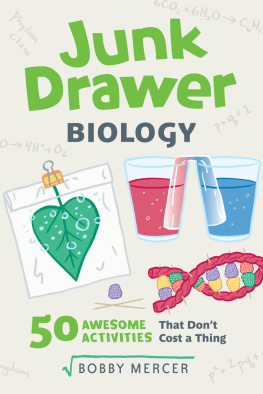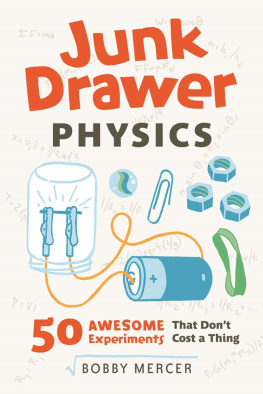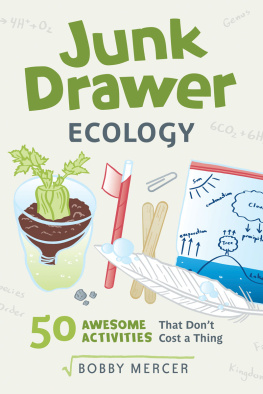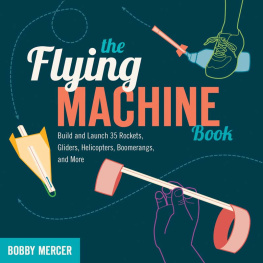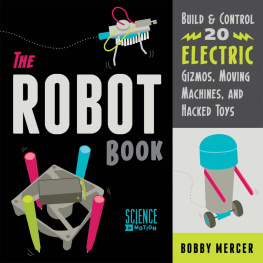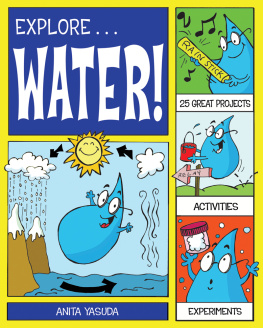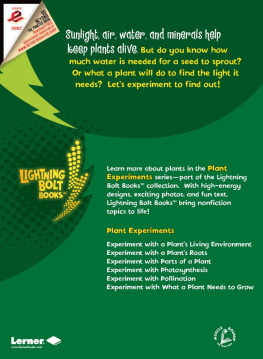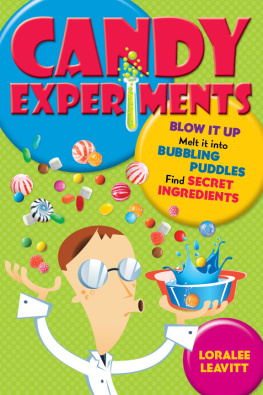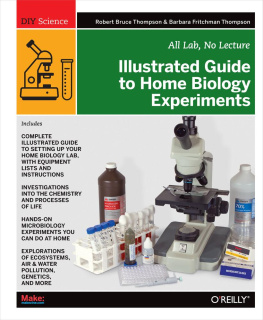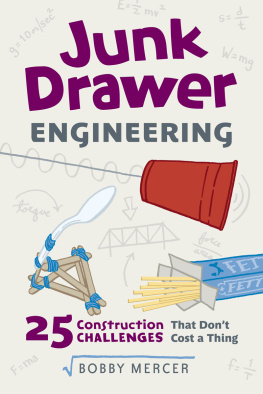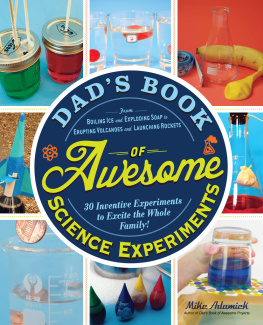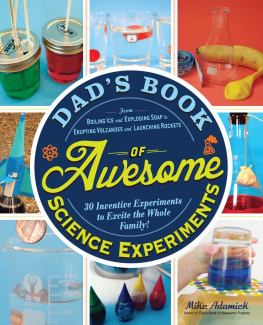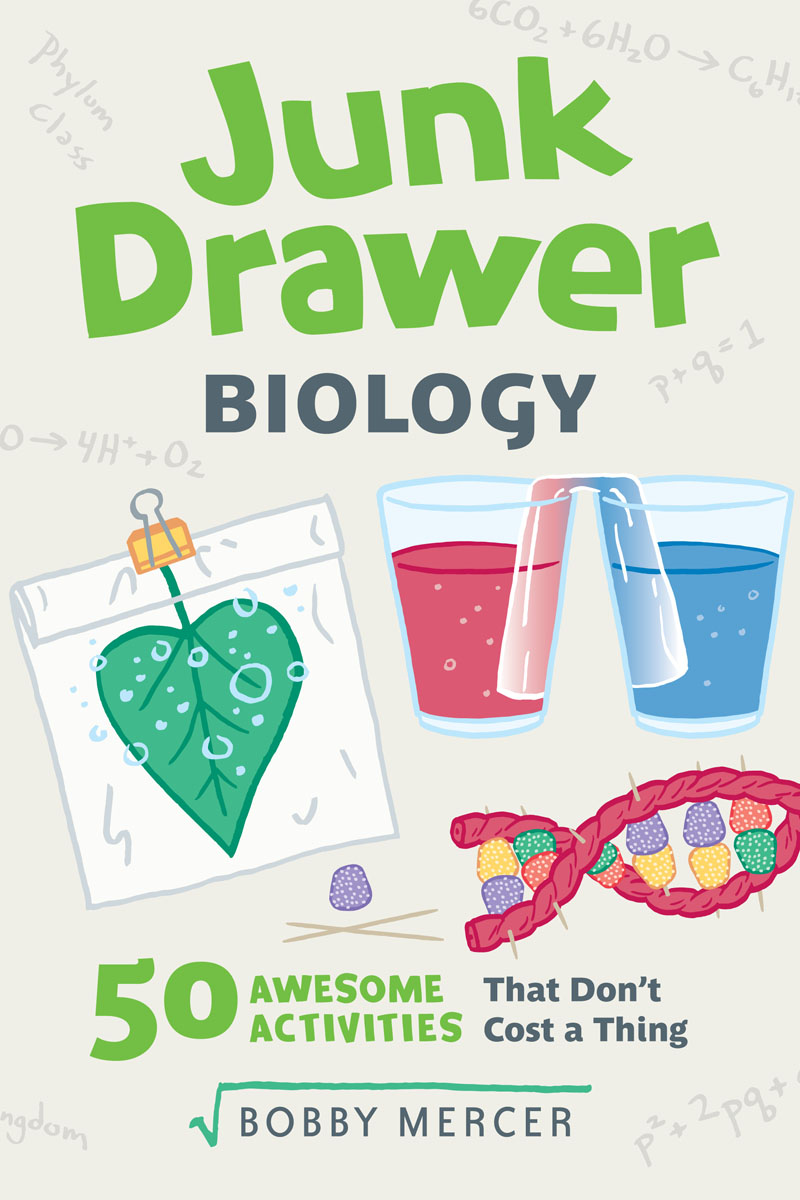
Copyright 2020 by Bobby Mercer
All rights reserved
Published by Chicago Review Press Incorporated
814 North Franklin Street
Chicago, Illinois 60610
ISBN 978-1-64160-289-1
Library of Congress Cataloging-in-Publication Data
Names: Mercer, Bobby, author.
Title: Junk drawer biology : 50 awesome experiments that dont cost a thing / Bobby Mercer.
Description: Chicago : Chicago Review Press, 2020. | Audience: Ages 9 to 12 | Audience: Grades 4-6 | Summary: Biology is the study of life, and all the wonderful, squishy, messy parts that living things are made of. And children love messy science, especially hands-on experimentation! Junk Drawer Biology will demonstrate that you dont need high-tech equipment to make learning fun-just what you can find in your recycling bin and around the house. Aspiring doctors can build a model of human lungs with balloons and a soda bottle, and a homemade stethoscope with tubing and plastic lid. Budding gardeners will germinate beans and explore how leaves breathe and sweat. And all ages will enjoy a double helix made of candy. Science educator Bobby Mercer provides readers with hands-on experiments to explain the building blocks of living matter for children of all ages. The projects can be modified to meet the skill levels of the children doing them, from elementary school kids to teenagers. Though each challenge includes suggested materials and one step-by-step, illustrated solution, children are encouraged to think further come up with more questions to answer. Educators and parents will find this title a handy resource to teach children while having a lot of fun-- Provided by publisher.
Identifiers: LCCN 2020002756 (print) | LCCN 2020002757 (ebook) | ISBN 9781641602891 (trade paperback) | ISBN 9781641602907 (pdf) | ISBN 9781641602914 (mobi) | ISBN 9781641602921 (epub)
Subjects: LCSH: Biology--Juvenile literature.
Classification: LCC QH309.2 .M47 2020 (print) | LCC QH309.2 (ebook) | DDC 570--dc23
LC record available at https://lccn.loc.gov/2020002756
LC ebook record available at https://lccn.loc.gov/2020002757
Cover design: Andrew Brozyna
Interior design: Sadie Teper
Interior photos: Bobby Mercer
Printed in the United States of America
5 4 3 2 1
To Team Science: Jennifer Allsbrook, Shannon Haynes, and Leslie Rhinehart.
Thanks for inspiring students every day.

Contents
Acknowledgments
Books dont happen without great people helping along the way. Thanks to Kathy Green, the best agent in the business. Thanks to Jerome Pohlen and the gifted people at Chicago Review Press for making this book a reality. Thanks to the wonderful people I work with; their thoughts, ideas, and encouragement mean the world to me. Shannon Haynes, Jennifer Allsbrook, Ethan Abbott, and Leslie Rhinehart have been invaluable shoulders to lean on. To Brandon Schweitzer, Josh Hill, Michelle Bean, and Aaron Greene, thanks for being supportive in all the right ways. As always, thanks to my wonderful better half, Michele, and my two partners in hands-on mayhem, Nicole and Jordan.
Introduction
Biology is the study of life. A living thing is anything that breathes, eats, grows, and dies. Plants, animals, bacteria, fungi, and more meet this criterion. Life is precious, whether it is a simple flower or a beautiful baby.
From the simple to the complex, life is also fun to learn about. Your amazing body is a great place to start. All the parts and pieces of your body are complex. Your body never stops. Your heart, lungs, and brain keep working even when you are asleep.
Plants and animals bring us so much joy. Pets make us smile and laugh. Flowers brighten our lives. Plants and animals (and you) are made up of cells. The cell is an incredible powerhouse that keeps us alive and keeps flowers growing.
The activities in this book make use of things you probably already have around the house. Play with Play-Doh to learn how cells grow and reproduce. Turn a chicken bone into rubber. Dissolve the shell off an egg and make it glow.
So, open your junk drawer and learn some biology.

1
Human Body
T he human body is more powerful than any computer. It controls every waking (and sleeping) minute of your life. The bones, blood, muscles, and all the organs in your body keep you running, jumping, and playing.
Have fun, enjoy these activities, and learn more about your incredible body.
Dominant Eye
You know that you are right-handed or left-handed, but do you also know you are right-eyed or left-eyed?
Biology Concept: Eye dominance
From the Junk Drawer:
- Sticky note (or any relatively small object you can place on a wall, like a clock)
Step 1: Place the sticky note or other chosen object on a wall. Make a triangle with right and left thumbs and index fingers and hold them out in front of you. With both eyes open, center the sticky note (or object) in the triangle. You should be at least 10 feet away from the sticky note.

Step 2: Close your left eye. If the object is still in the triangle, your right eye is dominant. Now close your right eye. If the object is still in the triangle, your left eye is dominant. Alternate closing each eye and watch the object move in and out of the triangle. Depending on the size of the distant object, it may only move part of the way out of the triangle with the dominant eye closed.

The Science Behind It
Like most people, you know if you are right-handed or left-handedyou have a dominant hand. But you also have a dominant eye. That means the image from that eye plays a greater role in your brain as it creates a complete picture of what you are looking at.
Knowing which eye is dominant is important in sports like baseball and softball. You want to turn your head so that your dominant eye sees more of the ball movement. It is also important in photography with fancy cameras. Since only one eye can look through the viewfinder, you want it to be the dominant eye. Because the image from the dominant eye will remain fairly clear even with different input from your other eye, you can keep both eyes open as you shoot the photographs. This allows you to see things outside the view-finder, like people walking into the scene, a bird you might want to photograph before it flies away, or a curb you dont want to trip over.
Science for the Ages
This is a great activity for kids of all ages. In a group setting, you could collect data comparing eye dominance and hand dominance. There is a correlation most of the timeright-handed people often have right-eye dominance, and left-handed people are often left-eye dominant. You can also research eye dominance on the internet with permission.
Next page
